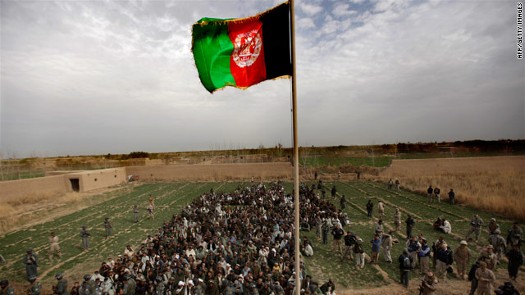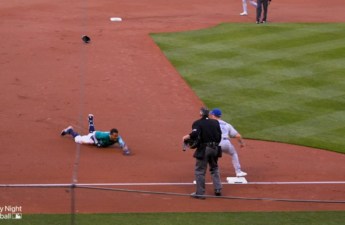
It’s not exactly people bringing down the statue of Saddam Hussein, but this kind of image is being levied to the American people as a sign of the grand liberation they’re bringing to a backwards and otherwise hopeless land in “the good war.”
But let’s let this picture speak for itself a little, shall we?
First off, we have a major offensive into a town/city that’s been described as ranging from a population of anywhere from 50,000 to 125,000 people. Presumably this is the town square, a patch of green field that may be what fallow poppies look like. If you’re going to have a ceremony for a city this size, it’s safe to say you’d pick a place reflective of the grandness of the city itself. This is a place that makes abandoned pueblos in New Mexico look like thriving modern metropolises.
Where are they hiding all those people?
If you look up Marja, you’ll find a hastily assembled Wikipedia article with no images and a discussion of the 2010 offensive, a vague 1950’s reference, and the latitude/longitude coordinates of 31°31′N 64°07′E. Plug those coordinates into Google Maps and you get an image of a dirt triangle in the middle of green fields like the one in the image above, revealing enough housing for at least 5,000 people scattered over an area the size of a small county. Where did all those people go?
Scroll around a bit and you’ll find an actual city, Laskar Gah, in the northeast of the region. But this is not the city of the offensive, not the site of the resistance, not the area in dispute. South of that is an actual fortress, the ancient stronghold of Qala Bist with its famous arch and corresponding inspirations.
This is not being billed as the war for Laskar Gah, though. It’s a war for poppy fields, like those depicted in our ceremonial flag-raising above. Look at all the guards on each side of the tiny ceremony. Surely they have to guard a formal ceremony in a land known for suicide bombings, right? This makes sense. But, uh, why are they facing toward the crowd rather than away from it? How does that make sense? They’re not guarding against a marauding individual who comes careening in to spoil the party, but rather preparing to gun down anyone in the dense packed crowd who makes a false move.
Which, frankly, doesn’t make any sense either. After all, with the crowd this closely packed, you couldn’t even see into the middle of the crowd. And that’s where a clever suicide bomber would be. With this density and proximity, they’d probably be able to wipe out the whole thing with one explosive. The fact that this didn’t happen indicates there was probably quite a perimeter and possible strip-search at the gates of this gathering. Which makes sense, but then why the inward-pointing guards?
The message of this picture seems clear to me. There just aren’t that many people in Marja, at least not that many who want to be associated with the ancient flag. The flag is fringed with gold, tinged with the blood of civilians who died for an uncertain future, liberated from their lives made miserable by the same invaders who ended it all. Is it any wonder you can’t get more people to come to this party?
There may not be stars and stripes on this flag, but there are wreaths of wheat. The flag waves over the amber waves of grain in the distance, planted to cover up the opium, cover up the still warm bodies of the dead. What if they threw a flag-raising and nobody came?


